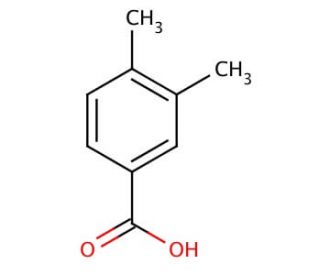

3,4-Dimethylbenzoic acid (CAS 619-04-5)
QUICK LINKS
3,4-Dimethylbenzoic acid, also known as 3,4-DMBA, is an organic compound classified as a member of the carboxylic acid family. With a molecular formula of C8H8O2, it holds various applications in organic synthesis, scientific research, and laboratory experiments. Extensively studied, 3,4-DMBA′s mechanism of action, biochemical effects, advantages and limitations for lab experiments, as well as potential future directions, have been thoroughly documented. Scientific research has found significant potential in 3,4-Dimethylbenzoic acid, making it a valuable model compound for investigating the impacts of carboxylic acids on biological systems. Moreover, it has been instrumental in studying the effects of aromatic compounds on enzyme activity. Additionally, researchers have utilized 3,4-Dimethylbenzoic acid to delve into the influence of carboxylic acids on protein structure, function, and cell membrane permeability. This versatile compound has also been employed as a model for exploring carboxylic acids′ role in lipid synthesis and metabolism. The precise mechanism of action of 3,4-Dimethylbenzoic acid remains partially elusive however, it is believed to interact with proteins and cell membranes. By binding to specific amino acid residues that constitute the active sites of enzymes, 3,4-Dimethylbenzoic acid can modulate enzyme activity, consequently affecting related metabolic pathways. Furthermore, its interactions with cell membranes can alter membrane permeability, leading to changes in intracellular transport processes and the overall cellular environment. 3,4-Dimethylbenzoic acid (3,4-DMBA) is a highly studied and versatile organic compound with diverse applications in scientific research. By shedding light on its synthesis, mechanisms of action, and various effects, we aim to enhance our understanding of this compound′s potential in advancing knowledge across multiple disciplines.
3,4-Dimethylbenzoic acid (CAS 619-04-5) References
- Toxicokinetics and metabolism of pseudocumene (1,2,4-trimethylbenzene) after inhalation exposure in rats. | Swiercz, R., et al. 2002. Int J Occup Med Environ Health. 15: 37-42. PMID: 12038862
- Repression of Salmonella Host Cell Invasion by Aromatic Small Molecules from the Human Fecal Metabolome. | Peixoto, RJM., et al. 2017. Appl Environ Microbiol. 83: PMID: 28754707
- Carboxyxanthones: Bioactive Agents and Molecular Scaffold for Synthesis of Analogues and Derivatives. | Ribeiro, J., et al. 2019. Molecules. 24: PMID: 30621303
- Species-specific enhancement of enterohemorrhagic E. coli pathogenesis mediated by microbiome metabolites. | Tovaglieri, A., et al. 2019. Microbiome. 7: 43. PMID: 30890187
- Metabolomics Analysis of the Deterioration Mechanism and Storage Time Limit of Tender Coconut Water during Storage. | Zhang, Y., et al. 2020. Foods. 9: PMID: 31947875
- Rumen Microbiome and Metabolome of Tibetan Sheep (Ovis aries) Reflect Animal Age and Nutritional Requirement. | Li, H., et al. 2020. Front Vet Sci. 7: 609. PMID: 32984417
- Escherichia coli Shiga Toxins and Gut Microbiota Interactions. | Lee, KS., et al. 2021. Toxins (Basel). 13: PMID: 34208170
- Ethnotherapeutic Uses and Phytochemical Composition of Physalis peruviana L.: An Overview. | Kasali, FM., et al. 2021. ScientificWorldJournal. 2021: 5212348. PMID: 34671227
- Multi-Omics Techniques for Analysis Antifungal Mechanisms of Lipopeptides Produced by Bacillus velezensis GS-1 against Magnaporthe oryzae In Vitro. | Zhang, Y., et al. 2022. Int J Mol Sci. 23: PMID: 35409115
- Multi-omics association analysis reveals interactions between the oropharyngeal microbiome and the metabolome in pediatric patients with influenza A virus pneumonia. | Hu, Q., et al. 2022. Front Cell Infect Microbiol. 12: 1011254. PMID: 36389138
- Dysbiosis of Oral Microbiota and Metabolite Profiles Associated with Type 2 Diabetes Mellitus. | Li, Y., et al. 2023. Microbiol Spectr. 11: e0379622. PMID: 36625596
- Gut microbiota-mediated secondary bile acid alleviates Staphylococcus aureus-induced mastitis through the TGR5-cAMP-PKA-NF-κB/NLRP3 pathways in mice. | Zhao, C., et al. 2023. NPJ Biofilms Microbiomes. 9: 8. PMID: 36755021
- Analysis of common and characteristic actions of Panax ginseng and Panax notoginseng in wound healing based on network pharmacology and meta-analysis. | Wang, Z., et al. 2023. J Ginseng Res. 47: 493-505. PMID: 37397412
- Initial steps in the degradation of 3,4-dimethylbenzoic acid by Pseudomonas putida strain DMB. | Baggi, G., et al. 1996. FEMS Microbiol Lett. 137: 129-34. PMID: 8998974
Ordering Information
| Product Name | Catalog # | UNIT | Price | Qty | FAVORITES | |
3,4-Dimethylbenzoic acid, 1 g | sc-238661A | 1 g | $28.00 | |||
3,4-Dimethylbenzoic acid, 10 g | sc-238661 | 10 g | $28.00 |
